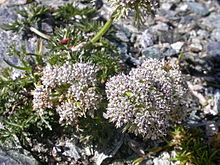Little motherwort
| Little motherwort | ||||||||||||
|---|---|---|---|---|---|---|---|---|---|---|---|---|

Small motherwort ( Pachypleurum mutellinoides ) |
||||||||||||
| Systematics | ||||||||||||
|
||||||||||||
| Scientific name | ||||||||||||
| Pachypleurum mutellinoides | ||||||||||||
| ( Crantz ) Holub |
The Small Lovage ( Pachypleurum mutellinoides (Crantz) Holub - formerly Ligusticum mutellinoides . (Crantz) Vill ), also dwarf Lovage called, was within the family of Umbelliferae (Apiaceae) as a plant previously to the genus Ligusticum asked. The assignment to the genus Pachypleurum was made according to data based on molecular genetics by Valiejo-Roman et al. 2006.
description
The small motherwort grows as a wintering green, perennial herbaceous plant that usually reaches heights of 5 to 15, rarely up to 20 centimeters. The base of the stem is covered with brown remains of leaves, but there is no tuft of fibers. The basal leaves are elongated ovate in outline, double to triple pinnate, with linear leaf lobes. Usually there is no stem leaf or at most one.
Flowering time is from July to August. The terminal, double-ended inflorescence is 8 to 20-rayed. The five to ten long-lasting bracts are pinnate to three-part and as long as the umbel rays. The husk leaves are numerous. The flowers are five-fold. The petals are pink or white.
The double achane is 3 to 5 millimeters long.
The species has chromosome number 2n = 22.
Occurrence
The disjoint area of Pachypleurum mutellinoides in Central Europe includes France , Italy , Switzerland , Germany , Poland and Slovakia ; in Southeastern Europe the former Yugoslavia and Romania ; the northern and eastern areas of the European part of Russia , western Siberia , southeastern Kazakhstan and northern Xinjiang .
The small motherwort thrives in Central Europe mainly at altitudes between 1800 and 2800 meters. It occurs scattered in the Alps ; however, it is also absent in some areas or is only very rare. In the Allgäu Alps, it rises in the Tyrolean part on the summit of the Muttekopf up to 2430 meters above sea level.
The small motherwort thrives best on low- lime and nitrogen-poor , shallow- rocky , but somewhat humus-rich loam soils in an alpine climate . It settles on patchy, stony lawns and mats , but also goes into crevices and on wind-swept ridges that remain free of snow in winter. It is a weak species of the Caricion curvulae association.
ecology
The small motherwort is a hemicryptophyte .
The small motherwort is very cold- resistant , probably the most resistant umbellifer in Central Europe. Their roots penetrate quite deep into the underground; this is important not only for the anchoring of the plant, but also for its supply with a minimum of water.
Taxonomy
The first publication took place in 1767 under the name ( Basionym ) Laserpitium mutellinoides by Heinrich Johann Nepomuk von Crantz . The new combination Ligusticum mutellinoides (Crantz) Vill. was published in 1779 by Dominique Villars in Prospectus de l'Histoire des Plantes de Dauphiné , p. 25. The current name is Pachypleurum mutellinoides (Crantz) Holub . Further synonyms for the plant species are, Laserpitium simplex L. , Ligusticum alpinum (Ledeb.) Kurtz , Pachypleurum alpinum Ledeb. , Pachypleurum simplex (L.) Rchb.
swell
Individual evidence
- ↑ CM Valiejo-Roman, VS Shneyer, TH Samigullin, EI Terentieva, MG Pimenov: An attempt to clarify taxonomic relationships in “family circle of the genus Ligusticum” (Umbelliferae-Apioideae) by molecular analysis. In: Plant Systematics and Evolution. Volume 257, No. 1-2, 2006, pp. 25-43, doi: 10.1007 / s00606-005-0383-8
- ↑ a b c d e f g h i j k Small motherwort. In: FloraWeb.de.
- ↑ a b Erich Oberdorfer : Plant-sociological excursion flora for Germany and neighboring areas . With the collaboration of Angelika Schwabe and Theo Müller. 8th, heavily revised and expanded edition. Eugen Ulmer, Stuttgart (Hohenheim) 2001, ISBN 3-8001-3131-5 , pp. 717-718 .
- ^ Ligusticum mutellinoides in the Germplasm Resources Information Network (GRIN), USDA , ARS , National Genetic Resources Program. National Germplasm Resources Laboratory, Beltsville, Maryland. Retrieved June 28, 2014.
- ↑ Erhard Dörr, Wolfgang Lippert : Flora of the Allgäu and its surroundings. Volume 2, IHW, Eching 2004, ISBN 3-930167-61-1 , p. 282.
- ^ Ralf Hand, 2011: Apiaceae. : Datasheet In: Euro + Med Plantbase - the information resource for Euro-Mediterranean plant diversity .
literature
- Otto Schmeil , Jost Fitschen (greeting), Siegmund Seybold: The flora of Germany and the neighboring countries. A book for identifying all wild and frequently cultivated vascular plants. 95th completely revised u. exp. Edition. Quelle & Meyer, Wiebelsheim 2011, ISBN 978-3-494-01498-2 .
- Eckehart J. Jäger (ed.): Excursion flora from Germany. Vascular plants: baseline. Founded by Werner Rothmaler . 20th, revised and expanded edition. Spektrum Akademischer Verlag, Heidelberg 2011, ISBN 978-3-8274-1606-3 .
- Henning Haeupler , Thomas Muer: picture atlas of the fern and flowering plants of Germany (= the fern and flowering plants of Germany. Volume 2). 2nd, corrected and enlarged edition. Published by the Federal Agency for Nature Conservation. Ulmer, Stuttgart 2007, ISBN 978-3-8001-4990-2 .
- Dietmar Aichele, Heinz-Werner Schwegler: The flowering plants of Central Europe. 2nd Edition. Volume 3. Franckh-Kosmos, Stuttgart 2000, ISBN 3-440-08048-X .
Web links
- Little motherwort. In: FloraWeb.de.
- Little motherwort . In: BiolFlor, the database of biological-ecological characteristics of the flora of Germany.
- Ligusticum mutellinoides Vill. In: Info Flora , the national data and information center for Swiss flora . Retrieved January 8, 2016.
- Thomas Meyer: dwarf motherwort data sheet with identification key and photos at Flora-de: Flora von Deutschland (old name of the website: Flowers in Swabia )
- Robert Flogaus-Faust: Ligusticum mutellinoides, dwarf motherwort (photo and data) Nafogu.de from July 13, 2005, accessed on June 27, 2018.
- data sheet
